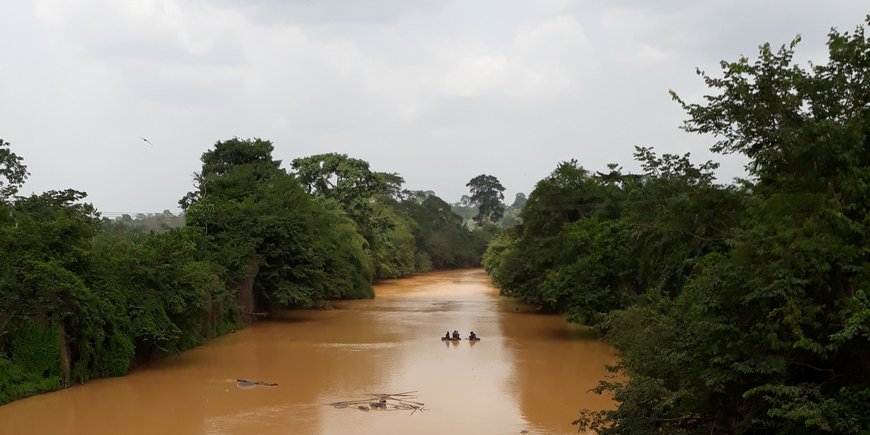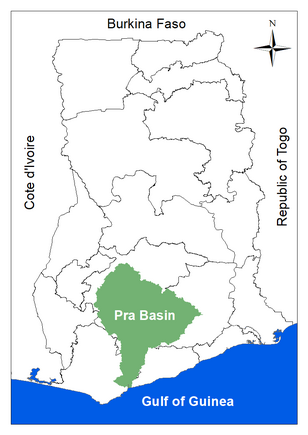Summary
Due to increasing pollution of the rivers, groundwater resources play a critical role in the water delivery systems for the approximately eight million people living in the Pra Basin catchment area in Ghana. However, there is uncertainty about the lasting quality of the groundwater. Previous hydrochemical characterizations of the basin have primarily relied on statistical approaches, lacking specific information on the mineral composition influencing groundwater quality. Addressing this knowledge gap, Evans Manu, Marco De Lucia and Michael Kühn from the GFZ German Research Centre for Geosciences and the University of Potsdam, have introduced a pioneering conceptual hydrogeochemical model for the basin. This model utilizes combinatorial inverse geochemical simulations to explain the chemical evolution of groundwater along a hypothetical flow path, yielding mineral assemblages that align well with the field observations. The modelling techniques presented here can be applied to other regions. The findings of this study have been published as a cover story in the journal ‘Minerals’.
Background: The water supply in the Pra Basin, Ghana
The Pra Basin is located in Southern Ghana (West Africa) and covers approximately 23,000 km2. The basin has sufficient water resources, including dense river networks and groundwater resources, to meet the current and future water demand for the population of around eight Million people. “Unfortunately, illegal mining activities have led to major pollution of most river bodies, compelling a greater reliance on groundwater as an alternative water source. However, the understanding of regional factors influencing groundwater quality remains limited, hindering effective and sustainable resource management efforts”, explains Evans Manu, PhD student at the GFZ and lead author of the study. Before starting his doctoral studies, he worked as a research scientist, focusing on groundwater, at the Water Research Institute of the Council for Scientific and Industrial Research in Ghana.
New approach for a better understanding of groundwater quality
Against this background, Manu developed a research project for his doctoral thesis in GFZ Section 3.4 “Fluid Systems Modelling”. It was funded by the German Academic Exchange Service (DAAD). For the study, now highlighted as the cover story in the journal ‘Minerals’, Evans Manu worked with Marco De Lucia, a scientist in the section, and Michael Kühn, the head of the section and Professor for Hydrogeology at the University of Potsdam. The researchers have developed a new conceptual model of the basin and tested it using inverse and reaction path geochemical models to elucidate which minerals drive the chemical evolution of groundwater.
The current work is based on earlier research by Evans Manu. He has explored and assessed groundwater resources in different areas of Ghana and beyond by using various geophysical techniques such as measuring electrical resistivity, electromagnetic and geophysical properties.
“Thus, this study pioneers a comprehensive investigation, integrating hydrochemical data, stable isotope ratios, and petrographic information from outcrops to unveil the geochemical processes driving the evolution of groundwater quality in the Pra Basin”, says Michael Kühn.
The conceptual model development
Generally, groundwater resources are fed by falling rain which percolates vertically through the soil zone and finally recharges the water bearing formations. In the underground the water flows horizontally according to the topography. The water interacts with diverse soils and rocks on its way.
For analysing reactions in natural geological systems such as rocks, minerals, and fluids, geochemical models are essential. These models are based on the principles of thermodynamics, kinetics, mass balance, and fluid dynamics, and they help to quantify geochemical processes, including dissolution, precipitation, sorption, and ion exchange, which control the groundwater chemical evolution.
In a previous study, the scientists used hierarchical cluster analysis to identify three regional zones in the Pra Basin as the basis of the hypothetical north-south flow direction of the groundwater, generally following the topography of the terrain: The northern zone with higher elevations is the main recharge area here and rainwater the main source. It contributes mainly in the northern zone and is neglectable in the central and southern part. The median groundwater composition was considered representative of each of the three zones. Simulations were run following the flow path of the rainwater infiltrating the northern zone, flowing underground from the northern to the central and from the central to the southern zone.
The combinatorial inverse modelling approach
In a combinatorial inverse modelling approach, all plausible mineral assemblages drawn from a pool of phases are screened to determine all possible combinations that would explain the field conditions. A total of 14 mineral phases was used: primary albite, anorthite, plagioclase, phlogopite, potassium feldspar and mica, iron(III) hydroxide and calcite and secondary kaolinite, Ca-montmorillonite, chlorite, quartz, pyrite and chalcedony. The ensembled best-matching computed equilibrium models were ranked with respect to the target concentrations. The finally predicted minerals were then refined using reaction path models to successively explain the observed composition along the flow path. All in all, the researchers characterized groundwater into four water groups and five subgroups, according to their pH-value and mineral composition.
Water-rock interactions govern the chemical evolution of groundwater
“Despite the large inherent heterogeneity in the hydrochemical dataset, the inverse models developed in this study successfully yielded distinct ‘best’ mineral assemblages that align with field observations”, resumes Evans Manu. The results underscore that weathering of silicate minerals, including albite, anorthite, plagioclase, potassium feldspar and chalcedony, are the main minerals driving groundwater chemical evolution in the Pra Basin.
“Overall, our study provides a concept of the chemical evolution of groundwater in a basin-scale environment with implications for the groundwater resource management in the Pra Basin. Furthermore, our numerical modelling workflow can be applied to similar regions with large heterogeneity in water chemistry and limited knowledge of aquifer mineralogy”, resumes Michael Kühn.
Original study: Manu, E., De Lucia, M. and Kühn, M., 2023. Water–Rock Interactions Driving Groundwater Composition in the Pra Basin (Ghana) Identified by Combinatorial Inverse Geochemical Modelling. Minerals, 13(7), p.899. DOI: https://doi.org/10.3390/min13070899




![[Translate to English:] Evans Manu stands by his pickup truck holding lab equipment.](/fileadmin/_processed_/4/9/csm_20230808_PM_Groundwater-Ghana_Manu_3_20200319_073236_web_8600fb3d84.jpeg)
![[Translate to English:] A concrete surface from which the connection of a borehole peeks out.](/fileadmin/_processed_/e/2/csm_20230808_PM_Groundwater-Ghana_Manu_4_20220202_112503_web_97a313839f.jpeg)
![[Translate to English:] A small stream amidst tall guests and bushes.](/fileadmin/_processed_/e/b/csm_20230808_PM_Groundwater-Ghana_Manu_5_20200312_092823_web_7bac966561.jpeg)
![[Translate to English:] A wire mesh fenced area in the landscape with exposed water pipes.](/fileadmin/_processed_/5/7/csm_20230808_PM_Groundwater-Ghana_Manu_6_20220205_111756_web_7974f989fd.jpeg)








![[Translate to English:] Torsten Sachs in front of a climate station on a field](/fileadmin/_processed_/3/9/csm__TorstenSachs_bearbeitet_GS_4a1365ef84.jpeg)

![[Translate to English:] left image flood at the Ahrtal: image from above, several houses are flooded; left image:: Heidi Kreibich;](/fileadmin/_processed_/4/4/csm_Bild2_9af0130e9f.png)



![[Translate to English:] Start der Vega Rakete](/fileadmin/_processed_/6/4/csm_20231201-kachel_Vega-VV23-launch_ESA-CNES-Arianespace_706716b68c.jpeg)









![[Translate to English:] Poster exhibition at the Brandenburg Hydrogen Day at the GFZ, some participants in the foreground](/fileadmin/_processed_/6/5/csm_Erster_Brandenburgischer_Wasserstofftag_GFZ_402fcec95e.jpeg)
![[Translate to English:] Group picture of the participants](/fileadmin/_processed_/9/4/csm_20231108_CAWa-Workshop-Tashkent_Gruppenbild_99ea779d8a.jpeg)

![[Translate to English:] [Translate to English:] Hörsaal](/fileadmin/_processed_/e/6/csm_H%C3%B6rsal_e21ac645fb.jpeg)


![[Translate to English:] The Delegations in the Historic Library on the Telegrafenberg. In the back there are from left to right, the Dutch Ambassador for Germany, Ronald van Roeden, the Dutch Minister for Education, Culture and Science, Robbert Dijkgraaf and the scientific director of the GFZ, Susanne Buiter.](/fileadmin/_processed_/d/b/csm_Kachel-2_9eba4b4212.jpeg)

